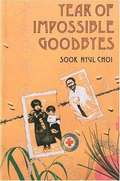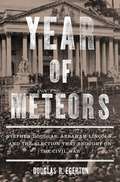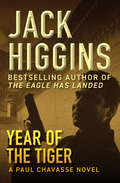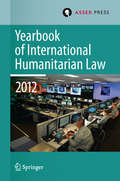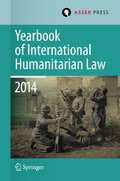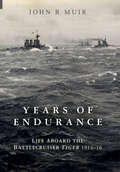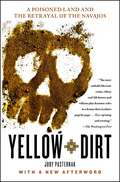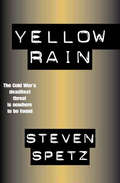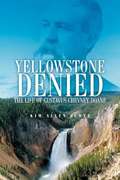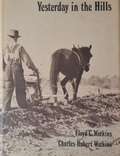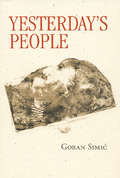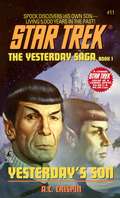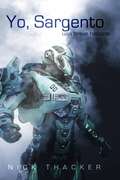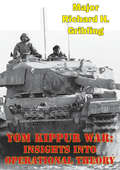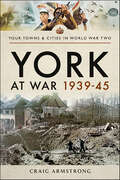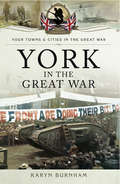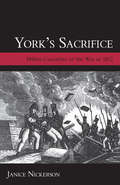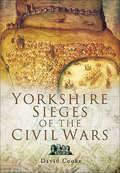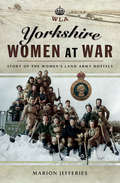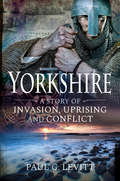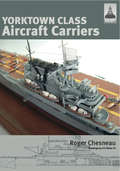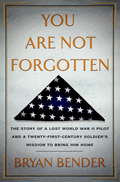- Table View
- List View
Year of Impossible Goodbyes
by Sook Nyul ChoiA young Korean girl survives the oppressive Japanese and Russian occupation of North Korea during the 1940s, to later escape to freedom in South Korea.
Year of Meteors: Stephen Douglas, Abraham Lincoln, and the Election That Brought on the Civil War
by Douglas R. EgertonAn analysis of the events that led up to the 1860 Presidential election and the machinations that culminated in the Civil War.
Year of the Tiger (The Paul Chavasse Novels)
by Jack HigginsA Cold War–era British spy infiltrates Chinese-occupied Tibet to rescue a scientist in this historical thriller by a New York Times–bestselling author. 1962. The Cold War is on. The key to the West beating the Soviets to the moon is scientist Dr. Karl Hoffner, living under house arrest in Chinese-controlled Tibet. In 1959, British Intelligence agent Paul Chavasse helped the Dalai Lama escape Tibet. Now his government has persuaded him to go back for Hoffner. Chavasse knows the language and the land. He also knows how important it is to get the scientist back alive. . . But trouble can be waiting for him anywhere. Perhaps on the illegal flight through the Himalayas or among the Chinese occupiers or the distrustful natives. Maybe with Tibetan freedom fighters or a trigger-happy army. Or at the hands of a beautiful woman . . . When the fate of the world hangs in the balance, a spy can never be too careful. Praise for Year of the Tiger &“Like his other novels, this one is loaded with action and adventure; it is Higgins at his best.&” —Booklist
Yearbook of International Humanitarian Law Volume 15, 2012
by Christophe Paulussen Terry D. Gill Robin Geiß Robert Heinsch Tim Mccormack Jessica Dorsey'Child Soldiers and the Lubanga Case' and 'The Tallinn Manual on the International Law Applicable to Cyber Warfare' are the two central themes of this volume. Each of these timely topics is addressed from three different angles, providing a truly comprehensive analysis of the subject. The book also features an article on the duty to investigate civilian casualties during armed conflict and its implementation in practice and an elaborate year in review, discussing developments that occurred in 2012. The Yearbook of International Humanitarian Law is the world's only annual publication devoted to the study of the laws governing armed conflict. It provides a truly international forum for high-quality, peer-reviewed academic articles focusing on this crucial branch of international law. Distinguished by contemporary relevance, the Yearbook of International Humanitarian Law bridges the gap between theory and practice and serves as a useful reference tool for scholars, practitioners, military personnel, civil servants, diplomats, human rights workers and students.
Yearbook of International Humanitarian Law Volume 17, 2014
by Christophe Paulussen Terry D. Gill Robin Geiß Tim Mccormack Jessica Dorsey Heike KriegerThis volume commemorates the centenary of the FirstWorld War (1914-2014) and aims to capture 100 years of warfare evolution. Amongthe main issues addressed are the changing nature of means and methods ofwarfare, the law of weaponry, and challenges to humanitarian assistance andprotection of the civilian population affected by armed conflict. Specifictopics include the legal regime governing nuclear weapons, the prohibition ofchemical weapons and arms control, the evolution of naval warfare, asymmetricconflicts, the law of occupation and cultural property. A comprehensive Year in Review also describes themost important events and legal developments that took place in 2014. The Yearbook ofInternational Humanitarian Law is the world's only annual publicationdevoted to the study of the laws governing armed conflict. It provides a trulyinternational forum for high-quality, peer-reviewed academic articles focusingon this crucial branch of international law. Distinguished by contemporaryrelevance, the Yearbook of InternationalHumanitarian Law bridges the gap between theory and practice and serves asa useful reference tool for scholars, practitioners, military personnel, civilservants, diplomats, human rights workers and students.
Years of Endurance: Life Aboard the Battlecruiser Tiger 1914–16
by John MuirThis memoir is perhaps one of the most immediate and vivid recollections of life in a Royal Navy battlecruiser to come out of the First World War. John Muir, a surgeon, was the senior medical officer aboard HMS Tiger from her commissioning in October 1914 until his departure in the autumn of 1916 when she was then undergoing repairs at Rosyth to the damage incurred at the battle of Jutland in June that year. Vivid, authoritative, empathetic and beautifully written, this memoir takes the reader right to the center of the action in the first years of the War. The book begins with a stirring account of a night in the wild North Sea with Tiger, head to wind in a gale, steaming at a reduced speed of 10 knots, her purpose to intimidate the German fleet ‘by the mere terror of our presence’. The scene set, Muir’s narrative then describes his experiences from the early days of mobilization, when he was the Senior Medical Officer of the barracks at Chatham, to his arrival aboard Tiger on the Clyde, her commissioning and the drilling of fifteen hundred officers and ratings as she put out to sea for the first time. In the first months of her career she was involved in intercepting the German raid on Scarborough before fighting the battlecruisers Derfflinger, Moltke, and Seydlitz at Dogger Bank. In May 1916 she found herself in line just astern of the doomed Queen Mary at Jutland. Muir had a ringside seat at these critical and decisive clashes and brings remarkable perception and clarity in the telling of his experiences. But more than a narrative of events, his story is also one about the officers and men who were his comrades in those years; about their qualities, their anxieties and the emotional dimension of their experiences. His insights are those of a man trained to understand the human heart, and they bring vividly to life a generation of men who fought at sea more than one hundred years ago. This is a spellbinding and gripping memoir, brought to a new audience in a handsome collectors’ edition for the first time since its publication in 1936.
Yellow Dirt
by Judy PasternakWINNER OF THE J. ANTHONY LUKAS WORK-IN-PROGRESS AWARD Atop a craggy mesa in the northern reaches of the Navajo reservation lies what was once a world-class uranium mine called Monument No. 2. Discovered in the 1940s--during the government's desperate press to build nuclear weapons--the mesa's tremendous lode would forever change the lives of the hundreds of Native Americans who labored there and of their families, including many who dwelled in the valley below for generations afterward. Yellow Dirt offers readers a window into a dark chapter of modern history that still reverberates today. From the 1940s into the early twenty-first century, the United States knowingly used and discarded an entire tribe for the sake of atomic bombs. Secretly, during the days of the Manhattan Project and then in a frenzy during the Cold War, the government bought up all the uranium that could be mined from the hundreds of rich deposits entombed under the sagebrush plains and sandstone cliffs. Despite warnings from physicians and scientists that long-term exposure could be harmful, even fatal, thousands of miners would work there unprotected. A second set of warnings emerged about the environmental impact. Yet even now, long after the uranium boom ended, and long after national security could be cited as a consideration, many residents are still surrounded by contaminated air, water, and soil. The radioactive "yellow dirt" has ended up in their drinking supplies, in their walls and floors, in their playgrounds, in their bread ovens, in their churches, and even in their garbage dumps. And they are still dying. Transporting readers into a little-known country-within-a-country, award-winning journalist Judy Pasternak gives rare voice to Navajo perceptions of the world, their own complicated involvement with uranium mining, and their political coming-of-age. Along the way, their fates intertwine with decisions made in Washington, D.C., in the Navajo capital of Window Rock, and in the Western border towns where swashbuckling mining men trained their sights on the fortunes they could wrest from tribal land, successfully pressuring the government into letting them do it their way. Yellow Dirt powerfully chronicles both a scandal of neglect and the Navajos' long fight for justice. Few had heard of this shameful legacy until Pasternak revealed it in a prize-winning Los Angeles Times series that galvanized a powerful congressman and a famous prosecutor to press for redress and repair of the grievous damage. In this expanded account, she provides gripping new details, weaving the personal and the political into a tale of betrayal, of willful negligence, and, ultimately, of reckoning.
Yellow Rain
by Steven SpetzA mysterious—and lethal—chemical weapon goes missing in this Cold War thriller of nonstop intrigue and suspense. When an Afghan village becomes paralyzed by the Soviets&’ new warfare, and a thick nerve gas suffocates innocent people, rumors of a deadly weapon find their way to the Pentagon—and into the hands of Lieutenant Colonel Mark Schad. Along with his three-man team, Lieutenant Colonel Schad will lead one of the riskiest covert operations known to the US Department of Defense in order to find one unexploded cylinder of Yellow Rain. But are these men up against something much greater than American intelligence is prepared to face?
Yellowstone Denied: The Life of Gustavus Cheyney Doane
by Kim Allen ScottFrontier soldier and explorer extraordinaire, Gustavus Cheyney Doane was no stranger to historical events. Between 1863 and 1892, he fought in the Civil War, participated in every major Indian battle in Montana Territory, and led the first scientific reconnaissance into the Yellowstone country. He was always close to being at the right place at the right time to secure lasting fame, yet that fame eluded him, even after his death. Finally, Kim Allen Scott rescues Doane from obscurity to tell the tale of an educated and inventive man who strove in vain for recognition throughout his life. Yellowstone Denied is a psychological portrait of a complex and intriguing individual. Raised in the West after traveling the Oregon Trail with his family, Doane enlisted in the “California Hundred” to fight for the Union. After a failed foray into politics, he returned to the army and headed the military escort of the first government exploration of Yellowstone in 1870. His report on that expedition attracted congressional recognition and contributed to the establishment of Yellowstone National Park but did not make Doane a household name. He fought the Sioux in 1876, the Nez Perces in 1877, and Geronimo in 1886. He also took part in preparations for the ill-fated Greeley Arctic expedition of 1881. During his thirty years in uniform, Doane nearly achieved the celebrity he sought, but twists of fate and, at times, his own questionable behavior denied it in the end. Scott’s critical biography now examines the man’s accomplishments and failures alike, and traces the frustrated efforts of Doane’s widow to see her husband properly enshrined in history. Yellowstone Denied is also a revealing look at military culture, scientific discovery, and western expansion, and it gives Doane the credit long denied him.
Yesterday in the Hills (Brown Thrasher Books Ser.)
by Floyd C. Watkins Charles Hubert WatkinsYesterday in the Hills recalls life in North Georgia from the 1890s until World War II and records vanished and vanishing folkways of the region. Here is folklore at its best--seen from the inside and mediated through the heart.Yesterday in the Hills is built upon the bedrock of experience and memory, but its sharply drawn characters and beautifully proportioned narrative transcend reminiscence and realistically depict hill-country life as it once was."Authentic, flavorful chapters about old-time hill people of North Georgia, their backbreaking field work, their song and play, their courtship, their neighborly exchange of help with the chores, their homemade remedies for illness and homemade practically everything else, their humor and their individuality."--Publishers Weekly"A gentle, humorous personal recollection of real people and the way they lived and worked."--Celestine Sibley
Yesterday's People
by Goran SimicThese eight stories deal with ordinary people in extraordinary circumstances, war and its aftershocks prominent among them, where the reality is often much more surreal than fiction.
Yesterday's Son: The Entropy Effect; The Covenant Of The Crown; Yesterday's Son; The Idic Epidemic (Star Trek: The Original Series #11)
by A.C. CrispinThe Romulans attack the planet Gateway, where Federation scientists are studying the Guardian of Forever -- the mysterious portal to the past. The Starship Enterprise must protect the Guardian -- or destroy it. But Spock has already used the portal to journey to the past. On the planet Sarpedion, 5,000 years ago, Spock knew a beautiful, primitive woman. Now he has gone back to meet his son!
Yo, Sargento Una breve historia
by Nick Thacker José Pedro Galindo Macías"Mi nombre es Renfro. Sargento Renfro, o simplemente Sargento... Sí, Sargento es mi primer nombre y sucede que es mi rango también. Nací en y a causa de esta guerra... pero esa es otra historia. Mi interés particular en el medio militar era casi nulo durante casi toda mi vida, pero como todos los de mi generación, fui reclutado en el servicio militar. Es la siguiente en la creciente colección de novelas de suspenso de acción/aventura de ciencia ficción de Nick Thacker... Tampoco existió nunca un momento durante la guerra en que yo no quisiera seguir con vida, así que combatí. Al principio luché en forma egoísta por mi propia vida, luego por mi pelotón y mi sección y finalmente por los individuos con los que prestaba mis servicios. Era una ruta tortuosa y probablemente sólo un poco egocéntrica, pero me trajo hasta aquí. ¡Los seguidores de Isaac Asimov y H.G. Wells, comienzan hoy la lectura de 'Yo, Sargento'!
Yom Kippur War: Insights Into Operational Theory
by Major Richard H. GriblingIn 1973, Israel found itself fighting its fifth major war against its Arab neighbors since achieving independence 25 years previously. This was a war in which both sides designed their military strategies within the framework of the political limitations set down by the two superpowers: the United States and the Soviet Union. As a result, both sides attempted to design campaigns in which key engagements set the conditions for a successful political solution.This paper begins with a broad overview of the conflict. It discusses three characteristics of the operational level of war: centers of gravity, culminating points, and the linkage of means and ends. It then analyzes how these characteristics significantly shaped the course of this war for both opponents. Finally, this study concludes that victory is only achieved by designing campaigns based on positive aims. For this war, the positive aim was defeating the opponent's source of strength.
York at War, 1939–45 (Your Towns & Cities in World War Two)
by Craig ArmstrongYork has often been overlooked when it comes to Britain’s wartime experience. The city was not though to have many industries of great wartime importance and it was not a part of the initial evacuation scheme. Yet this does not accurately reflect the wartime contributions of the city, as several of its large confectionary factories were converted to wartime use, while it was also a key rail hub, forming a vital link in the national network. Unbeknownst to the people of the city, York had been selected as the latest target in the Luftwaffe’s Baedeker Raids. In a short, sharp, blitz raid in the early hours of 29 April 1942, more than 3,000 houses were destroyed or damaged and almost 100 people killed while others were left seriously injured. Wartime York had a particularly close connection with the RAF as the city was surrounded by airbases. People became very used to seeing the uniforms of men and women from Bomber Command and the city was to prove very popular with airmen seeking relaxation. Places such as Betty’s Bar became infamous as airmen of almost every Allied nationality came to blew off steam. The nearby presence of the airfields also meant that the people of York and the surrounding area were witnesses to tragedies when aircraft crashed on their return to the bases.
York in the Great War (Your Towns & Cities in the Great War)
by Karyn BurnhamThe Great War touched every single town and city in Britain, barely a community escaped unscathed and the city of York was no different. Despite a long and tumultuous history, the seemingly brief period between 1914 and 1918 left as indelible a mark on York and its people as any period in the preceding millennium.Karyn Burnham explores what everyday life was like in York during the Great War and reveals how life changed as troops flocked into the city, Belgian refugees were welcomed, enemy 'aliens' were incarcerated and Zeppelins rained terror from the skies. Using contemporary publications, newspaper reports and photographs, York In The Great War tells the story of how the residents of York coped with the privations of war and discovers the pressures facing York's Quaker population when the introduction of conscription forced them to challenge their consciences.
York's Sacrifice: Militia Casualties of the War of 1812
by Janice NickersonNot only professional soldiers but also citizens serving as militiamen participated in the War of 1812. The militia’s contribution to the War of 1812 is not well understood. Even now, 200 years later, we don’t know how many Upper Canadian militia men died defending their home.York’s Sacrifice profiles 39 men who lost their lives during the war. They include 19 residents of the Town of York, five residents of York County, and 11 residents of Halton, Peel, and Wentworth Counties. Where possible, biographies include information about each man’s origin, residence, occupation, civic life, family, militia service, and circumstances of death. A section on records provides detailed guidance in finding and using records from the period to trace an ancestors militia service and life in this difficult time period.A complete list of men who served in the three York regiments during the war identifies those who were killed, injured, captured, or deserted.
Yorkshire Sieges of the Civil Wars
by David CookeThroughout recorded history Yorkshire has been a setting for warfare of all kinds - marches, skirmishes and raids, pitched battles and sieges. And it is the sieges of the Civil War period - which often receive less attention than other forms of combat - that are the focus of David Cooke's new history. Hull, York, Pontefract, Knaresborough, Sandal, Scarborough, Helmsley, Bolton, Skipton - all witnessed notable sieges during the bloody uncertain years of the Civil Wars. His vivid reconstructions allow the reader to visit the castles and towns where sieges took place and stand on the ground where blood was spilt for the cause for king or Parliament. Using contemporary accounts and a wealth of maps and illustrations, his book allows the reader to follow the course of each siege and sets each operation in the context of the Civil Wars in the North.
Yorkshire Women at War: Story of the Women's Land Army Hostels
by Marion JefferiesIn Yorkshire, 2015 marks the centenary of the founding of the first Land Girl Hostel, near Boroughbridge, by Lady Margery Lawson Tancred. Yorkshire Women at War deals with the Women's Land Army Hostel policy during the First World War and it is the first exhaustive account to examine hostel life in the austerity of war and post-war Yorkshire between 1939-50.Marion Jefferies's account of over fifty Women's Land Army hostels is filled with quirky stories about the hectic lives of tired, noisy and hungry girls. There are tales of how the girls slept, ate and socialized in shared dormitories. It records how one old farmhouse had only a single oil lamp, which lit the dormitory; how candles were stuck to the bunk beds and the girls were forced to complain about wax spilling on to their clothes and bedding; and how, at Stockton, bats flew freely in the the girls' dormitories.Some wardens were domineering, neglectful, spiteful and inefficient. One warden was bitter towards her charges and even boxed a girl's ears. However, several other wardens were homely, kind and a real friend to the young girls, and they were remembered with great affection.Included in the book are Miss Jacob Smith's inspection reports of hostel life, which illustrate the real trials, worries and happiness of the girls, some only 16 or 17 years old and away from home for the first time.This is a serious, well-researched history of the Women's Land Army Hostels in Yorkshire and thanks to the excellent memories and joviality of many veterans contacted by the author, it has been illumined by numerous light-hearted moments of what was to them 'the great adventure of their lives'.
Yorkshire: A Story of Invasion, Uprising and Conflict
by Paul C. LevittCelts, Romans, Saxons, Vikings . . . A sweeping history of this part of Northern England, and the many who have inhabited—and invaded—it over the centuries. This is a story about Yorkshire and its people, from the earliest period up to recent times. Foremost it is a story about invasion. Archaeological finds have shown that Yorkshire was occupied at a time when early hunters from continental Europe were not supposed to have ventured so far north. Growing populations on the European mainland made Yorkshire&’s fertile land and receding woodland a prime landscape for these first European farmers, and over time they would be followed by waves of invaders intent on pillage and land grabbing. From the north and west came the Picts and the Scots, while the Romans, Angles and Vikings arrived via the River Humber. The Normans would be the last to invade and seek to dominate everything they saw. Each invasion would leave its stamp on Yorkshire&’s culture and life, while battles would later be fought on Yorkshire soil during both the Wars of the Roses and the English Civil Wars. More than just a romp through the ages, this book reveals the key places where battles were fought and Yorkshire history was made.
Yorktown Class Aircraft Carriers (ShipCraft #3)
by Roger ChesneauThis fully illustrated guide offers historical context and step-by-step instruction for building and modifying US aircraft carrier models. This volume in the ShipCraft series covers the Yorktown class of American aircraft carriers. These legendary ships kept the Japanese at bay through World War II, in the dark days between Pearl Harbor and the Battle of Midway, where the USS Yorktown herself was lost. The USS Hornet launched the famous Doolittle Raid on Japan before being sunk at Santa Cruz in October 1942, but the USS Enterprise survived the fierce fighting of the early war years to become the US Navy's most decorated ship. This lavishly illustrated guide takes readers through a brief history of the development and careers of the Yorktown class. With its unparalleled level of visual information—including paint schemes, line drawings and photographs—it is simply the best reference for any modelmaker setting out to build one of these famous carriers.
You Are My Sunshine
by Rosie Archer1944, the darkest days of the war.Trixie and Vi are back in Gosport and doing their bit to help Britain win the war. Felling trees is backbreaking, but at least they know they're doing vital work.Trixie has a new boyfriend, Eddie. He's charming, handsome, and always flush with cash - a real Gosport catch, though Vi isn't so sure. Something about Eddie doesn't seem quite right, and Vi will do anything to convince Trixie that she's making a mistake with this relationship.Though Trixie loves Eddie, she finds it hard to forget Cy, the man she fell in love with at the start of the War, who was declared missing in action. As the bombs fall on Gosport both girls have big decisions to make. Will their friendship carry them through the hardest days?******************************What readers are saying about Rosie Archer'An amazing read' 5* Reader Review'Kept me hooked from the beginning' 5* Reader Review'Great characterisation' 5* Reader Review'A wonderful storyteller' 5* Reader Review'Heart-warming' 5* Reader Review
You Are My Sunshine: A heartwarming wartime story of friendship and love
by Rosie Archer1944, the darkest days of the war.Trixie and Vi are back in Gosport and doing their bit to help Britain win the war. Felling trees is backbreaking, but at least they know they're doing vital work.Trixie has a new boyfriend, Eddie. He's charming, handsome, and always flush with cash - a real Gosport catch, though Vi isn't so sure. Something about Eddie doesn't seem quite right, and Vi will do anything to convince Trixie that she's making a mistake with this relationship.Though Trixie loves Eddie, she finds it hard to forget Cy, the man she fell in love with at the start of the War, who was declared missing in action. As the bombs fall on Gosport both girls have big decisions to make. Will their friendship carry them through the hardest days?******************************What readers are saying about Rosie Archer'An amazing read' 5* Reader Review'Kept me hooked from the beginning' 5* Reader Review'Great characterisation' 5* Reader Review'A wonderful storyteller' 5* Reader Review'Heart-warming' 5* Reader Review
You Are My Sunshine: A heartwarming wartime story of friendship and love
by Rosie Archer1944, the darkest days of the war.Trixie and Vi are back in Gosport and doing their bit to help Britain win the war. Felling trees is backbreaking, but at least they know they're doing vital work.Trixie has a new boyfriend, Eddie. He's charming, handsome, and always flush with cash - a real Gosport catch, though Vi isn't so sure. Something about Eddie doesn't seem quite right, and Vi will do anything to convince Trixie that she's making a mistake with this relationship.Though Trixie loves Eddie, she finds it hard to forget Cy, the man she fell in love with at the start of the War, who was declared missing in action. As the bombs fall on Gosport both girls have big decisions to make. Will their friendship carry them through the hardest days?******************************What readers are saying about Rosie Archer'An amazing read' 5* Reader Review'Kept me hooked from the beginning' 5* Reader Review'Great characterisation' 5* Reader Review'A wonderful storyteller' 5* Reader Review'Heart-warming' 5* Reader Review
You Are Not Forgotten
by Bryan BenderAn inspiring and epic tale of loss and redemption about two American servicemen: a Marine Corps pilot who was shot down in WWII and the modern-day soldier determined to bring home his remains six decades later Major George Eyster V comes from a long line of military officers, dating back to the Revolutionary War. Army service was George's family legacy, but his tour of duty in Iraq left him disillusioned and questioning. He was making plans to end his army career but was offered a posting to J-PAC, an elite division armed with the latest detection and forensic technology. J-PAC's sole mission is to fulfill a solemn promise at the heart of the military code: bring all fallen soldiers home to the country for which they gave their lives. In 1944 Captain Ryan McCown, a dashing young Marine aviator assigned to the USS Nassau, was shot down over the jungles of Papua, New Guinea. McCown's diaries and letters home to his family and fiancée provide a moving, powerful portrait of the fears and costs of a very different war and underscore the pathos of the ultimate cost of duty. Eyster's mission with J-PAC eventually took him and his team deep into the sweltering interior of New Guinea in search of McCown's remains. It would be a fraught mission, complete with tropical diseases and black magic, at the end of which Eyster would not only repatriate a fallen veteran and fulfill a promise to deliver him to his loved ones but would also uncover something lost in himself-a sense of purpose in a promise between soldiers that is still worth fighting for.
